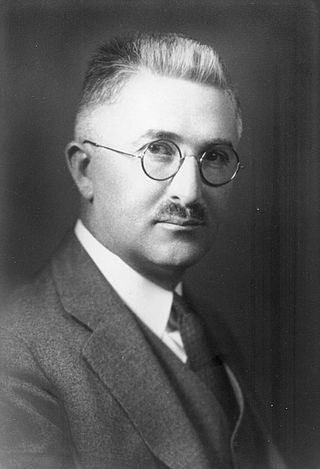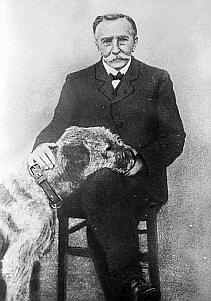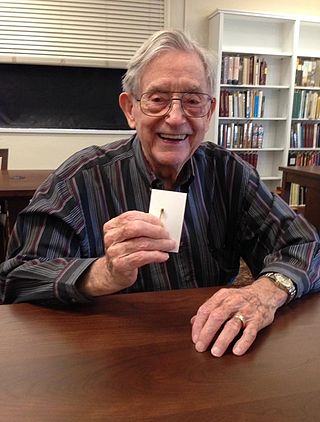Related Research Articles

Bell Labs is an American industrial research and scientific development company. Researchers from there are credited with the development of radio astronomy, the transistor, the laser, the photovoltaic cell, the charge-coupled device (CCD), information theory, the Unix operating system, and the programming languages B, C, C++, S, SNOBOL, AWK, AMPL, and others. Ten Nobel Prizes and five Turing Awards have been awarded for work completed at Bell Laboratories.

Charles Proteus Steinmetz was an American mathematician and electrical engineer and professor at Union College. He fostered the development of alternating current that made possible the expansion of the electric power industry in the United States, formulating mathematical theories for engineers. He made ground-breaking discoveries in the understanding of hysteresis that enabled engineers to design better electromagnetic apparatus equipment, especially electric motors for use in industry.

Bubble memory is a type of non-volatile computer memory that uses a thin film of a magnetic material to hold small magnetized areas, known as bubbles or domains, each storing one bit of data. The material is arranged to form a series of parallel tracks that the bubbles can move along under the action of an external magnetic field. The bubbles are read by moving them to the edge of the material, where they can be read by a conventional magnetic pickup, and then rewritten on the far edge to keep the memory cycling through the material. In operation, bubble memories are similar to delay-line memory systems.

Ralph Vinton Lyon Hartley was an American electronics researcher. He invented the Hartley oscillator and the Hartley transform, and contributed to the foundations of information theory.

This timeline of the telephone covers landline, radio, and cellular telephony technologies and provides many important dates in the history of the telephone.
Semiconductor memory is a digital electronic semiconductor device used for digital data storage, such as computer memory. It typically refers to devices in which data is stored within metal–oxide–semiconductor (MOS) memory cells on a silicon integrated circuit memory chip. There are numerous different types using different semiconductor technologies. The two main types of random-access memory (RAM) are static RAM (SRAM), which uses several transistors per memory cell, and dynamic RAM (DRAM), which uses a transistor and a MOS capacitor per cell. Non-volatile memory uses floating-gate memory cells, which consist of a single floating-gate transistor per cell.

In electronics, metastability is the ability of a digital electronic system to persist for an unbounded time in an unstable equilibrium or metastable state. In digital logic circuits, a digital signal is required to be within certain voltage or current limits to represent a '0' or '1' logic level for correct circuit operation; if the signal is within a forbidden intermediate range it may cause faulty behavior in logic gates the signal is applied to. In metastable states, the circuit may be unable to settle into a stable '0' or '1' logic level within the time required for proper circuit operation. As a result, the circuit can act in unpredictable ways, and may lead to a system failure, sometimes referred to as a "glitch". Metastability is an instance of the Buridan's ass paradox.
This is the history of the transistor. A transistor is a semiconductor device with at least three terminals for connection to an electric circuit. In the common case, the third terminal controls the flow of current between the other two terminals. This can be used for amplification, as in the case of a radio receiver, or for rapid switching, as in the case of digital circuits.
Amos Edward Joel Jr. was an American electrical engineer, known for several contributions and over seventy patents related to telecommunications switching systems.
John Burnette MacChesney II was an American scientist. A Bell Labs pioneer in optical communication, he was best known for his 1974 invention of the modified chemical vapor deposition (MCVD) process with colleague P.B. O'Connor, and for co-inventing high-purity "sol-gel" overcladding for optical fiber in the early 1980s. These inventions were key to the commercial manufacture of optical fiber.
Stewart David Personick is an American researcher in telecommunications and computer networking. He worked at Bell Labs, TRW, and Bellcore, researching optical fiber receiver design, propagation in multi-mode optical fibers, time-domain reflectometry, and the end-to-end modeling of fiber-optic communication systems.
Racetrack memory or domain-wall memory (DWM) is an experimental non-volatile memory device under development at IBM's Almaden Research Center by a team led by physicist Stuart Parkin. It is a current topic of active research at the Max Planck Institute of Microstructure Physics in Dr. Parkin's group. In early 2008, a 3-bit version was successfully demonstrated. If it were to be developed successfully, racetrack memory would offer storage density higher than comparable solid-state memory devices like flash memory.

A memristor is a non-linear two-terminal electrical component relating electric charge and magnetic flux linkage. It was described and named in 1971 by Leon Chua, completing a theoretical quartet of fundamental electrical components which also comprises the resistor, capacitor and inductor.
Andrew H. Bobeck was a Bell Labs researcher best known for his invention of bubble memory.
Rod C. Alferness was president of The Optical Society in 2008.

James Robert Biard was an American electrical engineer and inventor who held 73 U.S. patents. Some of his more significant patents include the first infrared light-emitting diode (LED), the optical isolator, Schottky clamped logic circuits, silicon Metal Oxide Semiconductor Read Only Memory, a low bulk leakage current avalanche photodetector, and fiber-optic data links. In 1980, Biard became a member of the staff of Texas A&M University as an Adjunct Professor of Electrical Engineering. In 1991, he was elected as a member into the National Academy of Engineering for contributions to semiconductor light-emitting diodes and lasers, Schotky-clamped logic, and read-only memories.
Robert Shelby Singleton is an American engineer, inventor, scientist, teacher of magnetics and computing. He invented magnetic core memory that was addressable by content rather than location, which is the precursor to modern content-addressable memory systems. He later contributed to the invention and development of virtual memory for computer systems, Computer Aided Design and Engineering systems, and complex signal processing algorithms and circuits.

Eby G. Friedman is an electrical engineer, and Distinguished Professor of Electrical and Computer Engineering at the University of Rochester. Friedman is also a visiting professor at the Technion - Israel Institute of Technology. He is a Senior Fulbright Fellow and a Fellow of the IEEE.
LeGrand Van Uitert was an American scientist who co-invented the first continuous beam optical MASER, now known as a laser, using a synthetic rare-earth doped garnet crystal. U.S. patent applications for the invention of the continuous wave optical MASER were filed on August 7, 1961, and issued as U.S. Patent Nos. 3,174,938 and 3,177,154.

Robert E Fontana is an engineer, physicist, and author who is noted for his contributions in the areas of magnetic recording and data storage on hard disk drives (HDD) and on digital tape recorders. His work has concentrated on developing thin film processing techniques for nano-fabrication of magnetic devices including Giant Magnetoresistance read heads now used universally in magnetic recording. Much of his career was with IBM in San Jose, California. He is a Fellow of the Institute of Electrical and Electronics Engineers and a member of the National Academy of Engineering.
References
- Bonyhard, P.; Geusic, J.; Bobeck, A.; Yu-Ssu Chen; Michaelis, P.; Smith, J., "Magnetic bubble memory chip design", IEEE Transactions on Magnetics, Volume 9, Issue 3, pages 433–436. September 1973.
- Michaelis, P.; Richards, W., "Magnetic bubble mass memory", IEEE Transactions on Magnetics, Volume 11, Issue 1, pages 21–25. January 1975.
- Letter from Paul Michaelis, Reader Feedback, Design News, November 13, 2007 [ permanent dead link ]
- United States Patent 4027298: Magnetic bubble memory bias magnet arrangement
- Paul+Charles+Michaelis United States Patent 4275459: Magnetic Bubble Detector Arrangement
- Paul+Charles+Michaelis United States Patent 3735370: Input for Single-Wall Domain Arrangement
- Paul+Charles+Michaelis United States Patent 4164790: Magnetic Bubble Packaging Arrangement
- Paul+Charles+Michaelis United States Patent 3675298: Micromanipulator for Multilevel Assembly
- Paul+Charles+Michaelis United States Patent 3454939: Magnetic Domain Propagation Device
- Paul+Charles+Michaelis United States Patent 3471819: Thermally Activated Bistable Switch
- Paul+Charles+Michaelis United States Patent 3508222: Readout Implementation for Magnetic Memory
- Paul+Charles+Michaelis United States Patent 3480925: Asynchronous Magnetic Circuit
- Paul+Charles+Michaelis Canadian Patent 2011561: Apparatus and Method for Making Low-loss Permanent Optical Fiber Splices
- Paul+C+Michaelis Canadian Patent 824830: Asynchronous Magnetic Circuit